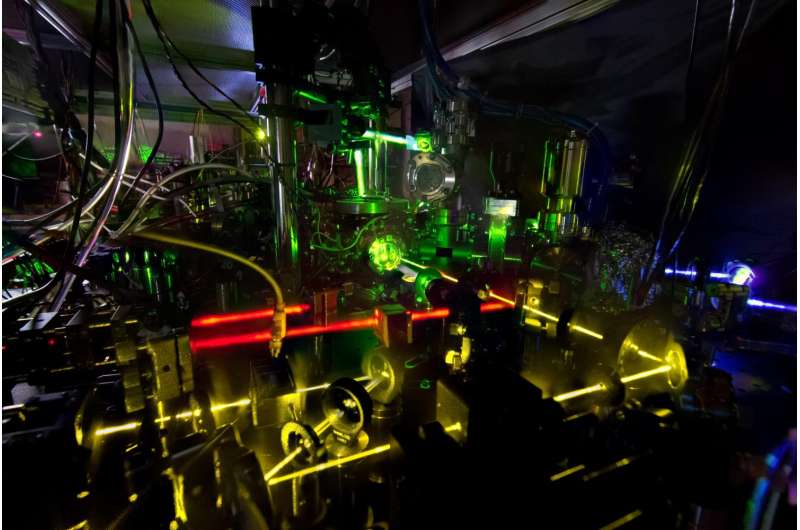NIST debuts dual atomic clock—and a new stability record

What could be better than a world-leading atomic clock? Two clocks in one.
Physicists at the National Institute of Standards and Technology (NIST) have combined two experimental atomic clocks based on ytterbium atoms to set yet another world record for clock stability. Stability can be thought of as how precisely the duration of each clock tick matches every other tick that comes before and after.
This extraordinary stability makes the ytterbium lattice clock a more powerful tool for precision tests such as whether the "fundamental constants" of nature are really constant, and searches for the elusive dark matter purported to make up much of the universe. The experiment demonstrating the double-clock design is reported in Nature Photonics.
"We eliminated a critical type of noise in the clock's operation, effectively making the clock signal stronger," NIST physicist Andrew Ludlow said. "This means we can reach a clock instability of 1.5 parts in a quintillion (1 followed by 18 zeros) in just a few thousand seconds. While this only slightly beats the record level of clock stability we demonstrated a few years ago, we get there 10 times faster."
NIST atomic clocks routinely perform at very high levels, but scientists continually tweak them to reduce slight imperfections. The new double-clock design eliminates a small but significant distortion in the laser frequency that probes and synchronizes with the atoms. The more stable the clock, the better its measurement power.
The new ytterbium lattice 'double clock' is the most stable clock in the world, although another NIST atomic clock, based on strontium and located at JILA, holds the world record for precision. Precision refers to how closely the clock tunes itself to the natural frequency at which the atoms oscillate between two electronic energy levels.
Both the ytterbium and strontium clocks tick at optical frequencies, much higher than the microwave frequencies of cesium atomic clocks used as time standards. An optical atomic clock operates by tuning the frequency of a laser to resonate with the frequency of the atoms' transition between two energy states. This atomic ticking is transferred to the laser for use as a timekeeping tool. Any noise or uncertainty affecting this process disturbs the laser frequency and, thus, the timekeeping precision.
Optical atomic clocks typically alternate laser probing of the atoms with periods of "dead time" during which the atoms are prepared and measured. During dead times, certain laser frequency fluctuations are not properly observed or compensated for in the laser tuning process. The resulting noise effects (first observed in the 1990s by G.J. Dick, then of the California Institute of Technology) has, until now, limited clock stability and precision.
NIST's new double-clock design has zero dead time—and is, therefore, nicknamed the ZDT clock—and virtually no dead-time noise, because it probes atoms continuously by switching back and forth from one atomic ensemble to the other. The two ensembles of 5,000 and 10,000 ytterbium atoms, respectively, are each trapped in a grid of laser light called an optical lattice and probed by a shared laser.
Measurements of the responses of the two atom ensembles are combined to produce a single, combined correction to the laser frequency. These measurements and corrections are made twice as fast as in a single clock. Because there is no dead-time noise, the new clock attains record stability levels 10 times faster than before. Crucially, the performance is now limited by the atomic system of the clock rather than the laser, a long-sought goal in physics that Ludlow calls a "dream" for future applications.
This approach can ultimately reduce atomic clock size and complexity, so the apparatus could be made portable enough to use outside the laboratory. The physical package is currently larger than a single clock, but eventually both atomic systems could share a single vacuum apparatus and simpler laser systems, thus reducing the overall size, Ludlow said. Portable optical atomic clocks could be distributed around the world for relativistic geodesy (gravity-based measurements of the shape of the Earth) or carried on spacecraft for tests of general relativity.
More information: M. Schioppo, R.C. Brown, W.F. McGrew, N. Hinkley, R.J. Fasano, K. Beloy, T.H. Yoon, G. Milani, D. Nicolodi, J.A. Sherman, N.B. Phillips, C.W. Oates and A.D. Ludlow. Ultra-stable optical clock with two cold-atom ensembles. November 28, 2016. Nature Photonics. nature.com/articles/doi:10.1038/nphoton.2016.231
Journal information: Nature Photonics
Provided by National Institute of Standards and Technology



















